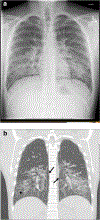Clinical and radiological characteristics of e-cigarette or vaping product use associated lung injury
- PMID: 32462343
- PMCID: PMC7906289
- DOI: 10.1007/s10140-020-01796-z
Clinical and radiological characteristics of e-cigarette or vaping product use associated lung injury
Abstract
Purpose: E-cigarette or vaping product use associated lung injury (EVALI) has received national attention as an epidemic resulting in cases of significant morbidity and mortality. We aim to present the clinical and imaging findings in adolescents with pulmonary symptoms from suspected EVALI.
Methods: Chest radiographs and CTs of adolescents (< 19 years) with acute pulmonary symptoms and history of vaping were reviewed by two radiologists in consensus. Clinical presentation and laboratory data were derived from the electronic medical records including pulmonary function tests (PFTs).
Results: Eleven patients were identified (9 male, mean 16.6 years). The most common presentation was progressive, subacute respiratory distress with abdominal pain. All but one of the patients tested positive for tetrahydrocannabinol. Chest radiograph features were notable for interstitial pattern of opacities (91%) and basilar abnormalities (82%). CT features were notable for ground-glass opacities (89%), interstitial opacities (78%), and subpleural sparing (67%). Eight patients underwent PFTs. Six had diffusing capacity measurement, which demonstrated impaired diffusion in 3 (50%). All patients received supportive treatment with supplemental oxygen and corticosteroids.
Conclusion: Adolescents with suspected EVALI commonly present with subacute respiratory distress with abdominal pain. Imaging findings include ground-glass opacities, subpleural sparing, and basilar opacities, most consistent with organizing pneumonia or hypersensitivity pneumonitis. Recognition of the common imaging findings may have significant patient management implications, especially if the diagnosis is not suspected clinically. The lung function effects of vaping are consistent with mildly reduced airflow, which improves on follow-up testing, and reduced diffusion capacity, which, concerningly, does not improve.
Keywords: Adolescents; Chest; EVALI; PFTs.
Conflict of interest statement
Figures



Similar articles
-
E-cigarette or vaping product use-associated lung injury in the pediatric population: imaging features at presentation and short-term follow-up.Pediatr Radiol. 2020 Aug;50(9):1231-1239. doi: 10.1007/s00247-020-04698-x. Epub 2020 Jun 3. Pediatr Radiol. 2020. PMID: 32495177
-
E-cigarette, or vaping, product use-associated lung injury in adolescents: a review of imaging features.Pediatr Radiol. 2020 Mar;50(3):338-344. doi: 10.1007/s00247-019-04572-5. Epub 2020 Jan 2. Pediatr Radiol. 2020. PMID: 31897566
-
Pediatric Chest Radiographic and CT Findings of Electronic Cigarette or Vaping Product Use-associated Lung Injury (EVALI).Radiology. 2020 May;295(2):430-438. doi: 10.1148/radiol.2020192778. Epub 2020 Mar 3. Radiology. 2020. PMID: 32125258
-
Radiological findings of e-cigarette or vaping product use associated lung injury: A systematic review.Heart Lung. 2021 Sep-Oct;50(5):736-741. doi: 10.1016/j.hrtlng.2021.05.004. Epub 2021 Jun 12. Heart Lung. 2021. PMID: 34130236
-
E-cigarette or vaping product use-associated lung injury: A review of clinico-radio-pathological characteristics.Respir Investig. 2022 Nov;60(6):738-749. doi: 10.1016/j.resinv.2022.06.011. Epub 2022 Aug 11. Respir Investig. 2022. PMID: 35963780 Review.
Cited by
-
Treatment of electronic cigarette or vaping product use-associated lung injury (EVALI) by corticosteroid and low-dose pirfenidone: Report of a case.Respirol Case Rep. 2021 Sep 21;9(10):e0845. doi: 10.1002/rcr2.845. eCollection 2021 Oct. Respirol Case Rep. 2021. PMID: 34584727 Free PMC article.
-
E-cigarette vaping associated acute lung injury (EVALI): state of science and future research needs.Crit Rev Toxicol. 2022 Mar;52(3):188-220. doi: 10.1080/10408444.2022.2082918. Epub 2022 Jul 13. Crit Rev Toxicol. 2022. PMID: 35822508 Free PMC article. Review.
-
Review of quantitative and functional lung imaging evidence of vaping-related lung injury.Front Med (Lausanne). 2024 Jan 24;11:1285361. doi: 10.3389/fmed.2024.1285361. eCollection 2024. Front Med (Lausanne). 2024. PMID: 38327710 Free PMC article.
-
Cannabis Vaping Among Youth and Young Adults: a Scoping Review.Curr Addict Rep. 2022;9(3):217-234. doi: 10.1007/s40429-022-00413-y. Epub 2022 May 7. Curr Addict Rep. 2022. PMID: 35573056 Free PMC article.
-
Predictors of Adherence to Smoking Cessation Medications among Current and Ex-Smokers in Australia: Findings from a National Cross-Sectional Survey.Int J Environ Res Public Health. 2021 Nov 21;18(22):12225. doi: 10.3390/ijerph182212225. Int J Environ Res Public Health. 2021. PMID: 34831981 Free PMC article.
References
-
- Chatham-Stephens K, Roguski K, Jang Y et al. (2019) Characteristics of hospitalized and nonhospitalized patients in a nationwide outbreak of E-cigarette, or Vaping, Product Use-Associated Lung Injury - United States, November 2019. MMWR Morb Mortal Wkly Rep 68:1076–1080. 10.15585/mmwr.mm6846e1 - DOI - PMC - PubMed
-
- Ellington S, Salvatore PP, Ko J et al. (2020) Update: product, substance-use, and demographic characteristics of hospitalized patients in a nationwide outbreak of E-cigarette, or Vaping, Product Use-Associated Lung Injury — United States, August 2019–January 2020. MMWR Morb Mortal Wkly Rep 69:44–49. 10.15585/mmwr.mm6849e1 - DOI - PMC - PubMed
-
- Blount BC, Karwowski MP, Shields PG, Morel-Espinosa M, Valentin-Blasini L, Gardner M, Braselton M, Brosius CR, Caron KT, Chambers D, Corstvet J, Cowan E, de Jesús VR, Espinosa P, Fernandez C, Holder C, Kuklenyik Z, Kusovschi JD, Newman C, Reis GB, Rees J, Reese C, Silva L, Seyler T, Song MA, Sosnoff C, Spitzer CR, Tevis D, Wang L, Watson C, Wewers MD, Xia B, Heitkemper DT, Ghinai I, Layden J, Briss P, King BA, Delaney LJ, Jones CM, Baldwin GT, Patel A, Meaney-Delman D, Rose D, Krishnasamy V, Barr JR, Thomas J, Pirkle JL, Lung Injury Response Laboratory Working Group (2020) Vitamin E acetate in bronchoalveolar-lavage fluid associated with EVALI. N Engl J Med 382:697–705. 10.1056/NEJMoa1916433 - DOI - PMC - PubMed
MeSH terms
Grants and funding
LinkOut - more resources
Full Text Sources
Medical
Research Materials

